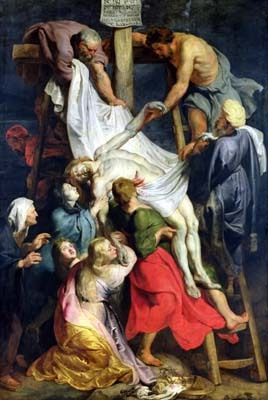Sprawled awkwardly on his back, Prometheus twists in agony as Jupiter’s broad-winged eagle gnaws implacably at his bowels. The Titan’s aptly titanic form is coiled like a spring. His left wrist, manacled to a rock, flexes and clenches; his rippling torso is convulsed by pain; his toes are helplessly clenched. The great bird, its task nearly complete, seeks for purchase on the body of its prey, digging its talons into Prometheus’s belly and at the same time clawing at his agonised face. With its beak the eagle gently, obscenely, eases his liver free from a gash in his body. The victim’s blood flows red while his vital organ itself is an unpleasantly authentic blue.
Prometheus Bound, on loan from the Philadelphia Museum of Art in America, is one of the prize exhibits in the cornucopian retrospective of the art of Peter Paul Rubens (1577-1640) which opened to the public yesterday at the Palais des Beaux-Arts, in the northern French town of Lille. This spotlit drama of a canvas could stand as an emblem of Rubens’s own vital and unruly genius. The titan of Baroque painting, Rubens was the dominant painter in an age of great painting. Astonishingly prolific, vastly influential, he shaped the future direction of his chosen art not only in Flanders, where he spent much of his working career, but also in Spain, in England, and perhaps above all in France, where his huge allegories of the life of Marie de Medici, painted for the court, by turns inspired and intimidated aspiring artists for two centuries and more. It seems extraordinary that there should never have been a major Rubens exhibition in France. The Lille exhibition – timed to coincide with the designation of that city as this year’s European Culture Capital – amounts to the repayment...

Major Rubens Exhibition at the Palais des Beaux Arts, Lille 2004
07-03-2004

